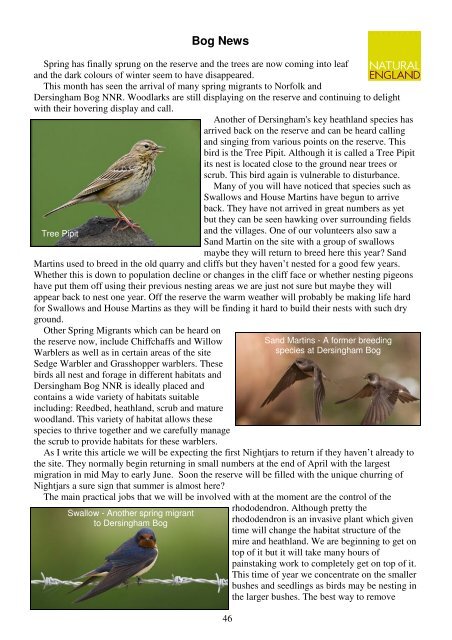village voice 70.pub - Dersingham Parish Council
village voice 70.pub - Dersingham Parish Council
village voice 70.pub - Dersingham Parish Council
You also want an ePaper? Increase the reach of your titles
YUMPU automatically turns print PDFs into web optimized ePapers that Google loves.
Bog News<br />
Spring has finally sprung on the reserve and the trees are now coming into leaf<br />
and the dark colours of winter seem to have disappeared.<br />
This month has seen the arrival of many spring migrants to Norfolk and<br />
<strong>Dersingham</strong> Bog NNR. Woodlarks are still displaying on the reserve and continuing to delight<br />
with their hovering display and call.<br />
Another of <strong>Dersingham</strong>'s key heathland species has<br />
arrived back on the reserve and can be heard calling<br />
and singing from various points on the reserve. This<br />
bird is the Tree Pipit. Although it is called a Tree Pipit<br />
its nest is located close to the ground near trees or<br />
scrub. This bird again is vulnerable to disturbance.<br />
Many of you will have noticed that species such as<br />
Swallows and House Martins have begun to arrive<br />
back. They have not arrived in great numbers as yet<br />
but they can be seen hawking over surrounding fields<br />
Tree Pipit<br />
and the <strong>village</strong>s. One of our volunteers also saw a<br />
Sand Martin on the site with a group of swallows<br />
maybe they will return to breed here this year? Sand<br />
Martins used to breed in the old quarry and cliffs but they haven’t nested for a good few years.<br />
Whether this is down to population decline or changes in the cliff face or whether nesting pigeons<br />
have put them off using their previous nesting areas we are just not sure but maybe they will<br />
appear back to nest one year. Off the reserve the warm weather will probably be making life hard<br />
for Swallows and House Martins as they will be finding it hard to build their nests with such dry<br />
ground.<br />
Other Spring Migrants which can be heard on<br />
the reserve now, include Chiffchaffs and Willow<br />
Warblers as well as in certain areas of the site<br />
Sedge Warbler and Grasshopper warblers. These<br />
birds all nest and forage in different habitats and<br />
<strong>Dersingham</strong> Bog NNR is ideally placed and<br />
contains a wide variety of habitats suitable<br />
including: Reedbed, heathland, scrub and mature<br />
woodland. This variety of habitat allows these<br />
species to thrive together and we carefully manage<br />
the scrub to provide habitats for these warblers.<br />
As I write this article we will be expecting the first Nightjars to return if they haven’t already to<br />
the site. They normally begin returning in small numbers at the end of April with the largest<br />
migration in mid May to early June. Soon the reserve will be filled with the unique churring of<br />
Nightjars a sure sign that summer is almost here?<br />
The main practical jobs that we will be involved with at the moment are the control of the<br />
Swallow - Another spring migrant<br />
to <strong>Dersingham</strong> Bog<br />
46<br />
Sand Martins - A former breeding<br />
species at <strong>Dersingham</strong> Bog<br />
rhododendron. Although pretty the<br />
rhododendron is an invasive plant which given<br />
time will change the habitat structure of the<br />
mire and heathland. We are beginning to get on<br />
top of it but it will take many hours of<br />
painstaking work to completely get on top of it.<br />
This time of year we concentrate on the smaller<br />
bushes and seedlings as birds may be nesting in<br />
the larger bushes. The best way to remove


